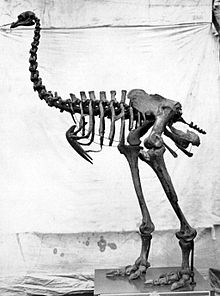Heavy-footed moa
| Heavy-footed moa Temporal range: Late Pleistocene-Holocene
| |
|---|---|

| |
| P. elephantopus skeleton photographed by Roger Fenton | |
| Scientific classification | |
| Domain: | Eukaryota |
| Kingdom: | Animalia |
| Phylum: | Chordata |
| Class: | Aves |
| Infraclass: | Palaeognathae |
| Order: | †Dinornithiformes |
| Family: | †Emeidae |
| Genus: | †Pachyornis |
| Species: | †P. elephantopus
|
| Binomial name | |
| Pachyornis elephantopus | |
| Synonyms | |
|
List
| |
The Heavy-footed moa (Pachyornis elephantopus) was a type of moa. It only lived in New Zealand. It could not fly.[3]
Description[change | change source]
The heavy-footed moa was about 1.8 m (5.9 ft) tall. It weighed 145 kg (320 lb).[4]
Discovery[change | change source]
The heavy-footed moa was discovered by W.B.D. Mantell at Awamoa, near Oamaru.[4]
Distribution and Habitat[change | change source]
The heavy-footed moa only lived in the South Island of New Zealand.[5][4] They lived in dry and open habitats such as grasslands, shrublands and dry forests.
Diet[change | change source]
The heavy-footed moa is a herbivore like other types of moa. It eats tough plants. Its only predator was the Haast's eagle.
References[change | change source]
- ↑ Brands, S. (2008)
- ↑ Checklist Committee Ornithological Society of New Zealand (2010). "Checklist-of-Birds of New Zealand, Norfolk and Macquarie Islands and the Ross Dependency Antarctica" (PDF). Te Papa Press. Retrieved 4 January 2016.
- ↑ Grzimek, Bernhard (2003–2004). Grzimek's animal life encyclopedia. Neil Schlager, Donna Olendorf, American Zoo and Aquarium Association (2nd ed.). Detroit: Gale. ISBN 0-7876-5362-4. OCLC 49260053.
- ↑ 4.0 4.1 4.2 "New Zealand Birds | Birds | Gallery | Heavy-Footed Moa, Pachyornis elephantopus". www.nzbirds.com. Retrieved 2021-09-01.
- ↑ Worthy, T.H. (1990). "An analysis of the distribution and relative abundance of moa species (Aves: Dinornithiformes)". New Zealand Journal of Zoology. 17 (2): 213–241. doi:10.1080/03014223.1990.10422598. ISSN 0301-4223.
